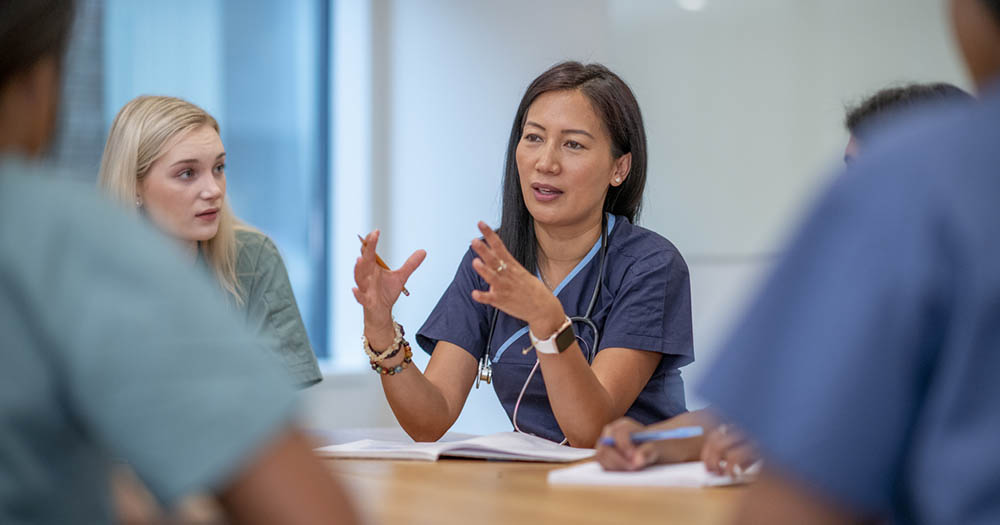Hypoglycaemia is a major barrier to intensive glycaemic control, and occurs in 7.7% of all diabetes hospital admissions, leading to increased length of hospital stay, cost and mortality rates (Curkendall et al, 2009; Turchin et al, 2009). The majority of hypoglycaemic episodes are managed by nurses and guidance for this is provided in the The Hospital Management of Hypoglycaemia in Adults with Diabetes Mellitus (Stanisstreet et al, 2010) document.
The present authors have addressed nurses’ management of inpatient hypoglycaemia following an audit of their local practice. Hypo-boxes were introduced as well as hypoglycaemia management guidelines and staff training to standardise hypoglycaemia management. Subsequent re-audits identified some recurring deficits, such as not treating blood glucose levels of 3–4 mmol/L, not using the correct carbohydrates to treat hypoglycaemia, not rechecking blood glucose levels after 15 minutes and not performing laboratory glucose checks during hypoglycaemic episodes.
In this article, the authors present the findings of a study to determine if gaps in nurses’ knowledge explain the recurring deficits in the hypoglycaemia management re-audits.
Methodology
The authors developed a questionnaire (Box 1) based on their hospital hypoglycaemia management guidelines. Nurses on the adult wards were asked to participate over a 1-week period. This study was conducted in a tertiary hospital in London.
Results
A total of 100 responses were received from participants (80% staff nurses and 20% senior or charge nurses). All the participating nurses came across patients with diabetes in their wards. At present, all patients with diabetes undergo regular capillary blood glucose (CBG) monitoring (at 0600, 1200, 1800 and 2200 hours and, additionally, at 0200 hours as needed). The mean age of patients in previous audits was 70 years. Of these, 93% of unique hypoglycaemic episodes occurred in people with type 2 diabetes. Recurrent hypoglycaemic episodes were common among older people with severe renal impairment on sulphonylureas, and in people taking insulin, those with cognitive dysfunction and those with poor oral intake. A great proportion (47% [64/137]) of the hypoglycaemic episodes in the audits occurred between 2200 and 0600 hours.
The responses to the questionnaire (Box 1) showed that only 51% of the participating nurses were formally trained to manage hypoglycaemia and 77% were aware of the new hospital guideline. Only 58% considered a blood glucose level of <4 mmol/L to be hypoglycaemia (Figure 1); this may explain why some patients in the previous audits with CBG levels of 3–4 mmol/L were not treated. Only 28% of nurses recognised all symptoms of hypoglycaemia and 29% recognised just three or less symptoms. This is an important finding as many people with hypoglycaemia might go unnoticed with potentially serious consequences.
In terms of the treatment of hypoglycaemia, 73% responded that they would use some form of rapid-acting carbohydrate, but only 10% said they would treat with quick-acting carbohydrates followed by slowly digested carbohydrates. Only 33% would recheck CBG within 15 minutes, while 28% were not sure when to recheck CBG and others were variable from 30 minutes to 1 hour. At least 57% did not feel the need for measurement of venous blood glucose levels during a hypoglycaemic episode and in the previous hypoglycaemia management audits this measurement was not performed in any patient.
More positively, the majority (73% [100/137]) of hypoglycaemic episodes in inpatients were successfully detected during routine testing, and in the survey 75% of participating nurses felt they were detecting hypoglycaemic episodes by routine checking. This was an unexpected finding both in the previous hypoglycaemia management audits and the survey. This highlights the problem of hypoglycaemia unawareness in inpatients with diabetes.
People on insulin are at a high risk of hypoglycaemia (UK Prospective Diabetes Study Group, 1998). Omission of insulin after managing a hypoglycaemic episode is a common problem and this was highlighted in the present study as 66% of the nurses felt that they would and should omit insulin after treatment of a hypoglycaemic episode (Figure 2). Of the surveyed nurses, 76% felt that hypoglycaemia increases mortality rates.
Discussion
This study was undertaken with the intention of it being a training module rather than research. Participants of this study took it as a learning experience and this prompted a rapid adaptation of the hypoglycaemia management guideline.
In diabetes care, the prevention of microvascular complications is the main benefit of intensive blood glucose management, but the downside is the increased frequency of severe hypoglycaemic episodes (NICE–SUGAR Study Investigators et al, 2009). There have been reports of increased mortality rates in people receiving critical care associated with tight glycaemic control, particularly owing to hypoglycaemia. When severe hypoglycaemic episodes occur, the individual needs assistance from others for treatment, regardless of the blood glucose value. A recent meta-analysis of large cardiovascular (CV) outcome studies in diabetes including ACCORD (Action to Control CV Risk in Diabetes), ADVANCE (Action in Diabetes and Vascular Disease) and VADT (Veterans Affairs Diabetes Trial) suggests that there is a direct correlation between the incidence of severe hypoglycaemia and CV mortality (Mannucci et al, 2009). It is therefore essential, particularly in older people with long durations of diabetes and CV disease (CVD), to avoid severe hypoglycaemia and choose therapy with the least risk of causing hypoglycaemia.
Studies have shown that the prevalence of inpatient diabetes is 10–25% (Sampson et al, 2007). In a study by Turchin et al (2009), the incidence of hypoglycaemic episodes was 7.7% in inpatients with diabetes and this is associated with increased length of stay, cost and mortality (Curkendall et al, 2009). In these studies, the blood glucose cut-off level for hypoglycaemia was 50 mg/dL (2.8 mmol/L). However, the present authors’ local policy is to treat blood glucose levels of <4 mmol/L as hypoglycaemia. A study by Bailon et al (2009) showed a significantly higher incidence of hypoglycaemia during nighttime compared with that experienced during the day. The audits carried out by the present authors showed similar results. As these audits were performed by reviewing patient notes and charts it is difficult to explain the high incidence of nocturnal hypoglycaemia, but it may be related to inappropriate timing or size of meals in relation to diabetes medications.
There are multiple potential causes for inpatient hypoglycaemia including (Stanisstreet et al, 2010):
- Inappropriately timed diabetes medications for meal.
- Incorrect insulin prescribed or administered.
- Recovery from acute illness or stress.
- Intravenous insulin infusion with or without glucose infusion.
- Missed or delayed meals.
- Smaller levels of carbohydrates than usual.
- Change of the timing of the biggest meal of the day.
- Lack of access to snacks in between meals.
- Prolonged duration of “nil by mouth”.
- Reduced appetite.
Individuals aged >65 years, who represent the majority of people with type 2 diabetes, are at high risk of experiencing severe hypoglycaemia (Zammitt and Frier, 2005; Amiel et al, 2008). Bremer et al (2009) showed that subjective hypoglycaemia unawareness is a significant problem in people aged >65 years compared with those aged <65 years despite having no difference in the counter-regulatory hormonal response. The majority of the patients from the present authors’ audits were also aged >65 years and had multiple comorbidities including diabetic complications and CVD. Hypoglycaemia unawareness also increases the risk of severe hypoglycaemia by up to three-fold (Meneilly et al, 1994; Spyer et al, 2000). The adrenergic response to hypoglycaemia is gradually attenuated by antecedent hypoglycaemia as the threshold for activation shifts to lower plasma glucose concentrations (Cryer, 2004), which results in hypoglycaemia unawareness.
The present authors found that most hypoglycaemic events were detected during routine testing. This may have resulted from reduced hypoglycaemia awareness, cognitive impairment or a reduced level of consciousness owing to acute illness. Although omitting insulin therapy following the management of an episode of a hypoglycaemic episode is strongly advised against, 66% of the nurses who responded to the survey felt that they should omit insulin therapy. Getting this message across is one of the main priorities for future training sessions.
Future plans
As hypoglycaemia is a significant problem for inpatients with diabetes with its associated morbidity, mortality and high cost, good understanding of the impact of hypoglycaemia and knowledge of management are essential for nurses to treat these episodes effectively. Recognition of hypoglycaemic symptoms by staff is important to treat these events appropriately. Addressing these deficiencies by providing compulsory training for all nursing staff is now being planned.
Diabetes link nurses have been identified in each clinical area and they will ensure that their staff are trained and supported. They will also be the first port of call for other ward nurses. The present authors plan to repeat the survey after this compulsory training. Institutional blood glucose monitoring is an emerging technology for monitoring blood glucose levels in hospitalised patients; consideration is being given to introducing this system. This has been associated with improved glucose control (Boaz et al, 2009) and will also make future audits much easier.
A similar lack of knowledge among medical and nursing house staff has been demonstrated in a study by Trepp et al (2010). This study focused on questions related to inpatient management of diabetes such as antidiabetes therapy, hypoglycaemia, ketoacidosis and blood glucose targets. In the study by Trepp et al, participants scored high on questions on hypoglycaemia (59±25%) and low on questions on oral antidiabetes therapy (32±32%) and ketoacidosis (32±22%). In the future, assessing these different areas of knowledge would be helpful to tailor training needs.
Conclusion
The results of this survey show that there is a lack of knowledge of inpatient hypoglycaemia management among nurses, thus providing potential explanations for recurrent deficits in re-audits. The surprising result in this survey was the detection of a significant proportion of hypoglycaemic episodes by routine testing. The authors believe that by providing compulsory training for nurses, standardised management of hypoglycaemia for inpatients with diabetes can be achieved.





Key scientific developments presented at the conference.
6 Aug 2025